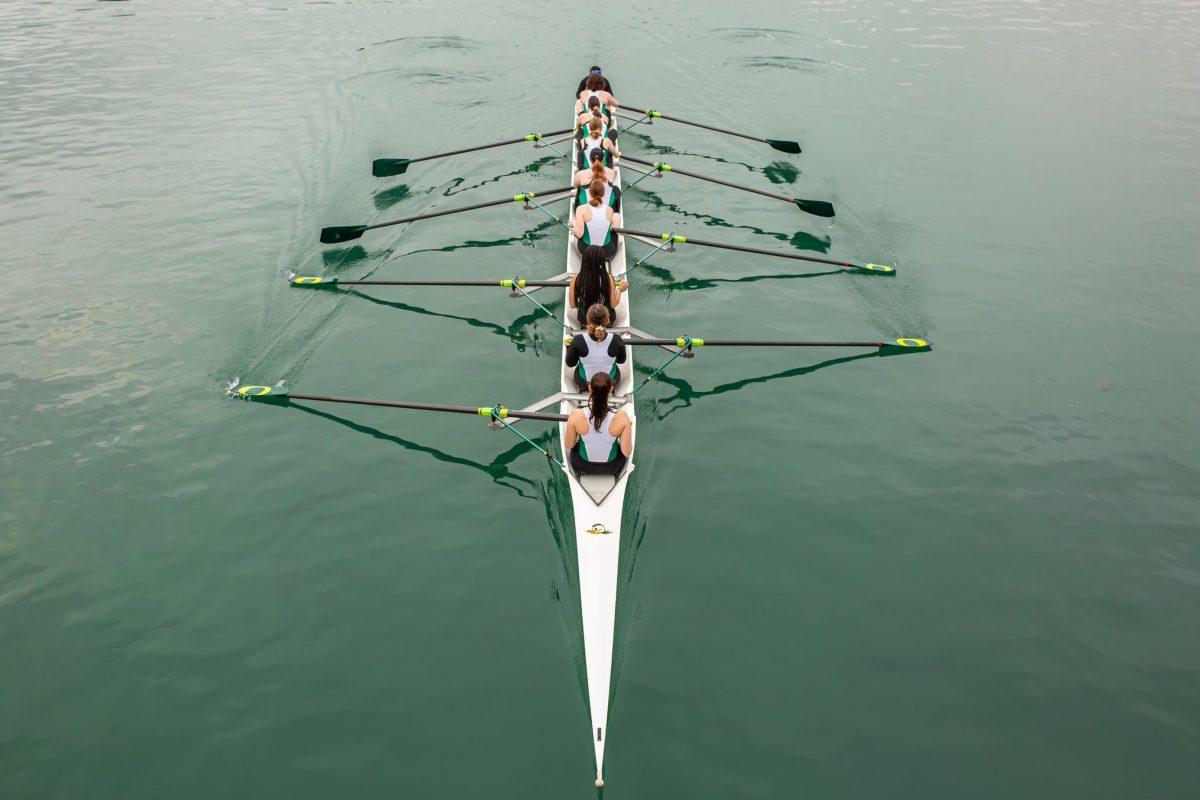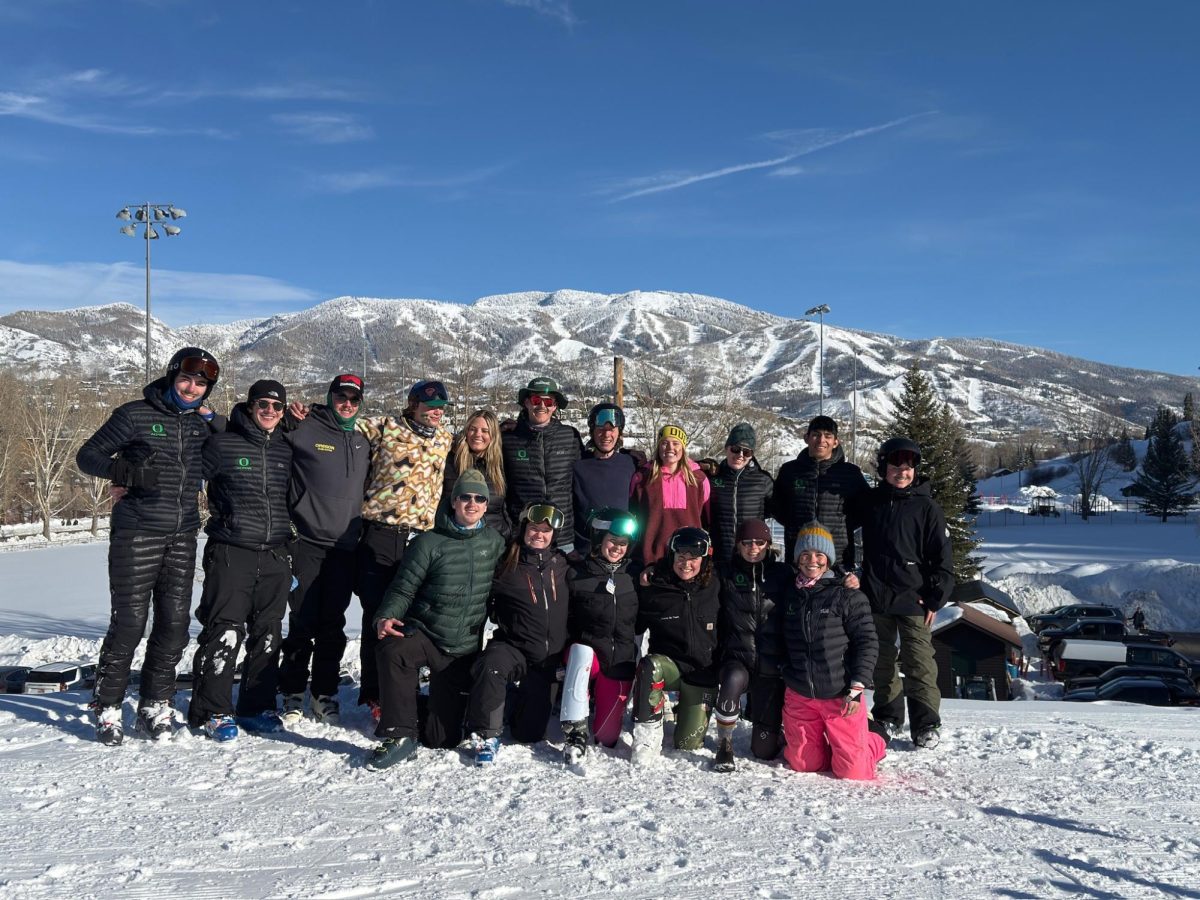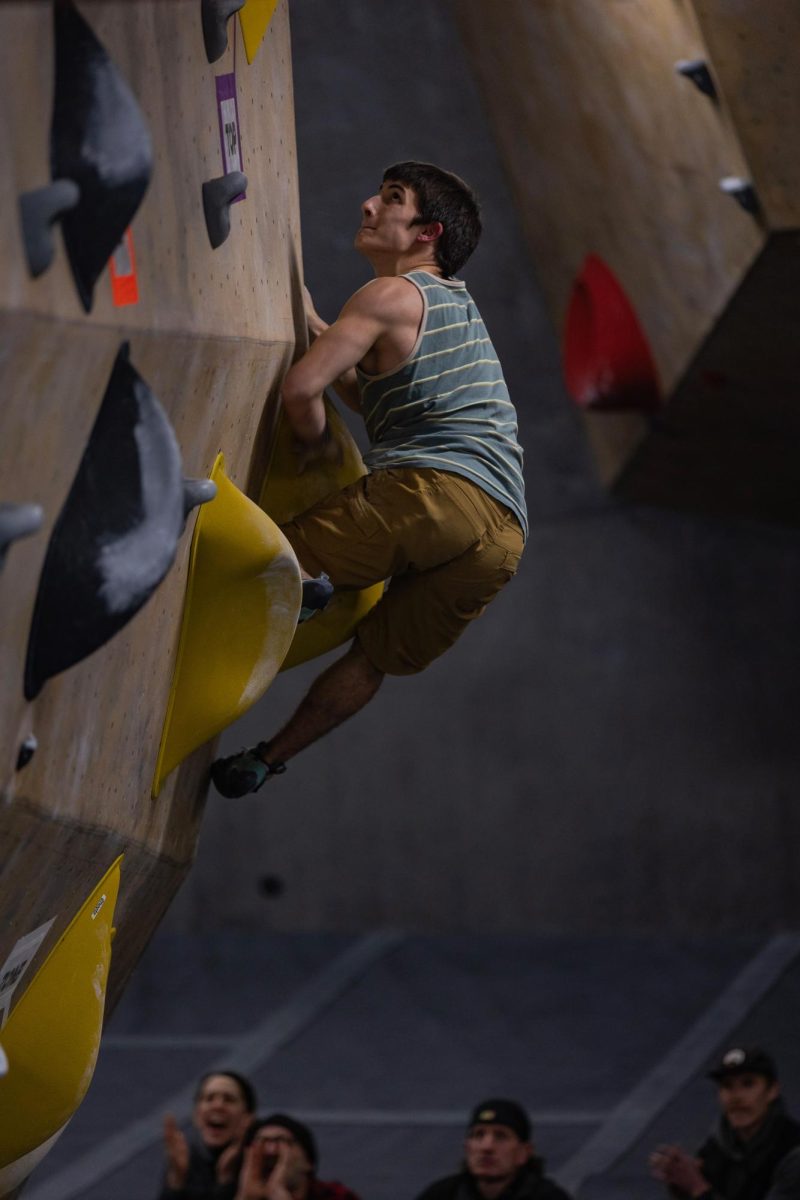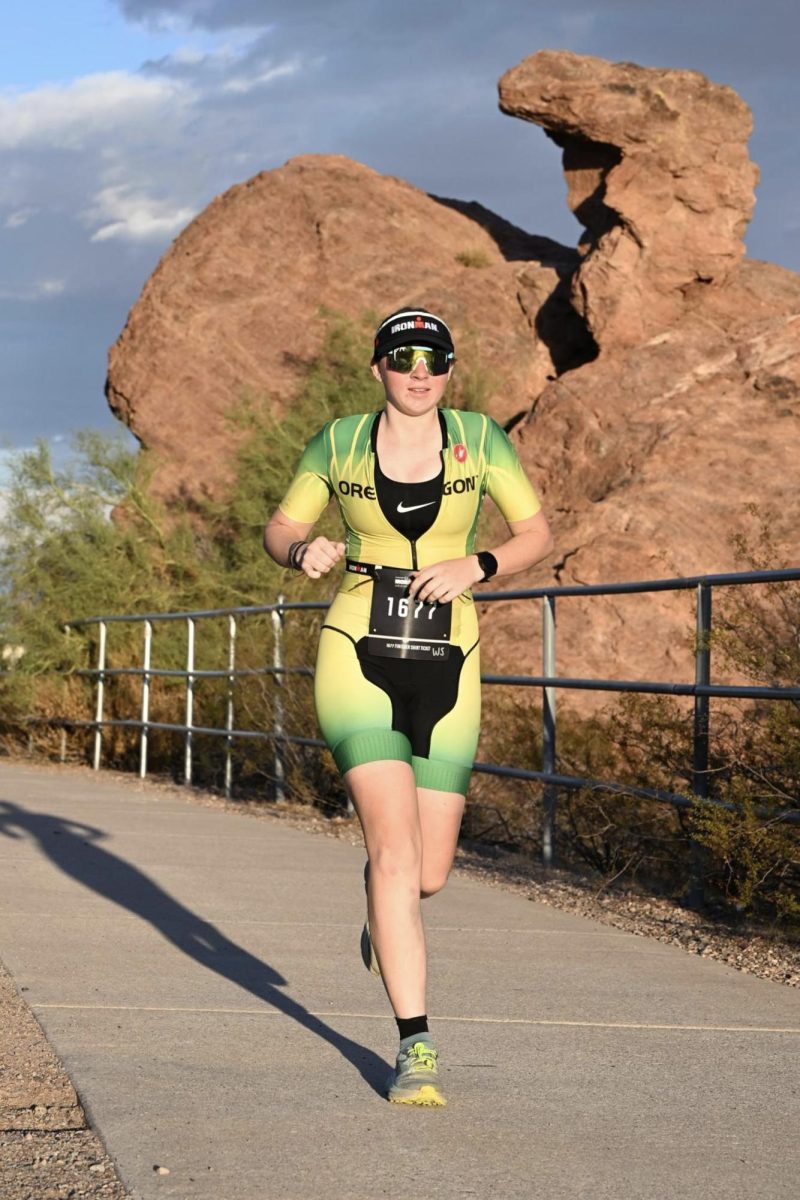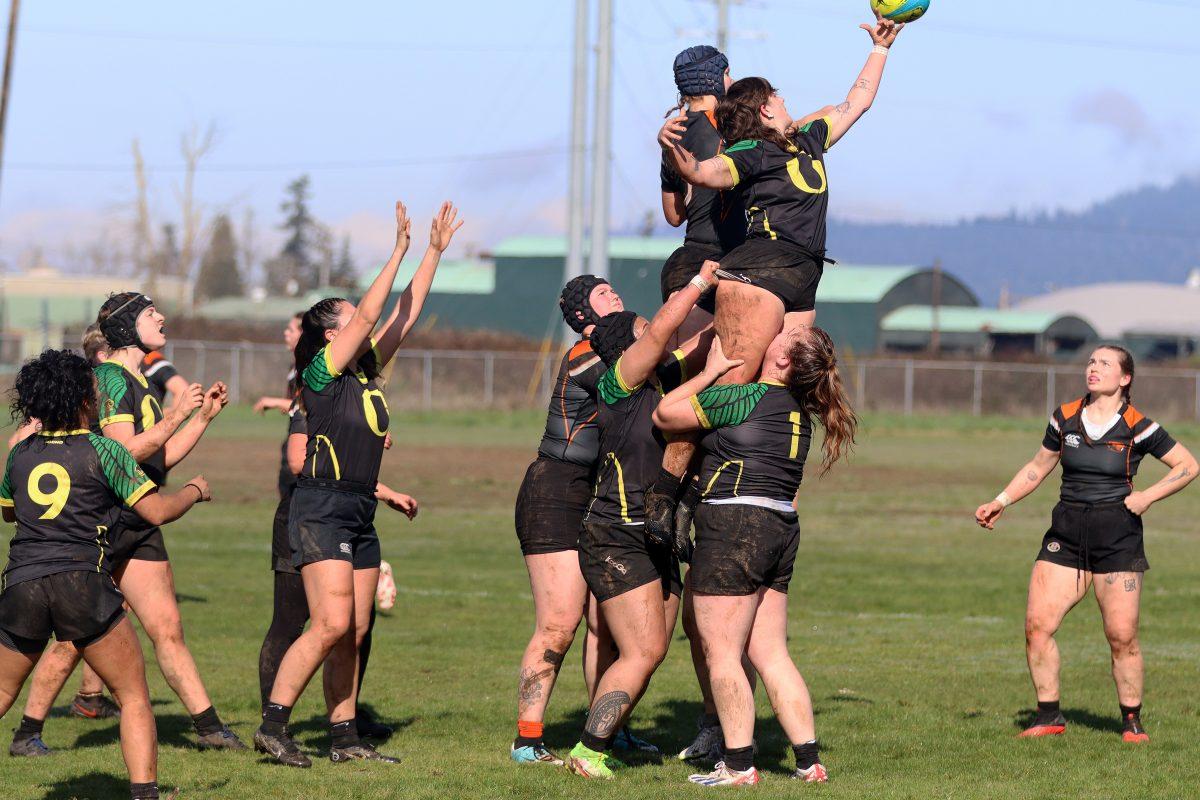Dexter Reservoir sits tucked off Oregon Route 58 on the Middle Fork Willamette River 16 miles southwest of Eugene.
It’s over 1.5 miles wide and 56 feet at its deepest point. The 7-plus miles of surrounding shore hold a trio of state parks, and for 55 years it has been the home of the University of Oregon’s rowing program.
In the fall of 1971, Dexter Reservoir served as the platform for a breakthrough in gender equality that permanently shifted the sport’s landscape. Now it’s become a haunting reminder of how much farther there is to go.
———————
The rule still confounds Hannah Abers.
The University of Oregon junior ascended from women’s captain to club president of the school’s rowing program this year, and she’s using the gravity of her newfound role to take on a long overdue matter –– one that jeopardizes the competitive opportunities of her and her female teammates.
In the run up to the Pac-12 Tournament on May 15, hosted on Dexter Reservoir, Abers learned Oregon’s women’s boats would be barred from competition, a NCAA Constitutional stipulation to blame.
Women’s rowing is an NCAA sport, while men’s rowing isn’t. Because women’s rowing is subject to NCAA rules, club teams like UO are barred from competing in NCAA-sanctioned events like the Pac-12 Tournament. Hannah Abers says that rule is outdated and unfair to women’s club teams that work just as hard as the varsity teams but aren’t allowed to compete.
Countable Competition, Statute 31.3.3.1: “For NCAA team-championship selection purposes, competition is countable only when the teams played are varsity intercollegiate teams of four-year, degree-granting institutions that conduct a majority of their competition in that team sport against varsity intercollegiate teams of United State four-year degree-granting institutions.”
Read: No club teams allowed.
Except Oregon’s male rowers, which account for roughly 20 out of the 50 athletes, were granted the opportunity to compete. Men’s rowing is governed by the Intercollegiate Rowing Association. The IRA has no rule that suspends competition because of a club program’s participation.
The NCAA’s statute disproportionately affects female athletes. It’s robbing them of equal treatment, Abers said.
“I still think that there is this unspoken idea that women are somehow less competitive and less noteworthy,” Abers said. “And I think that this is even more true for club women.”
In 2018, one year before Abers joined the program, the Oregon women competed at the site of the Pac-12s at Lake Natoma, California, one day before the sanctioned Pac-12 Tournament’s kick-off. The Ducks paid their competition fees for a separate regatta the day prior and while disheartened they couldn’t complete in the coming day’s tournament, they planned to support the men in their endeavors. But NCAA officials wouldn’t even let them off the bus. For over 45 minutes, the women were forced to sit and stew in the hot vehicle –– all because of an NCAA rule.
“I hate that there’s this insinuated fear of losing associated with us, when in reality, the women want the same opportunities to go out and do their best against the best that the men have,” Abers said.
Since learning of the NCAA’s law in the winter, Abers has mobilized UO’s rowing program toward a full fledged push for change. Members have attempted to raise awareness. Some made fliers and crafted press releases, while others reached out to local news organizations.
“We are one team; there is no women’s Oregon rowing and men’s Oregon rowing,” freshman rower Elise Haverland said. “We’re all together.”
Former Oregon rower and current head women’s coach Zach Hedeen added: “I’ve just been kind of being a cheerleader in a lot of ways… [Abers] is someone who has a really strong vision for what the team is and what the team can be.”
The men’s side has made it their issue, too.
In early January, Abers enlisted Don Costello — a retired judge, UO’s rowing coach in the early 70s turned attorney and part-time mentor for the current rowing team — to help pen their complaints to the UO General Counsel. UO responded within hours. But aside from garnering support from the University itself, it’s been challenging to get the ball rolling, especially given Oregon is one of only three Pac-12 teams with club women’s programs.
In April, Abers met with Tammy Newman, a representative from the Pac-12. According to Abers, Newman conveyed frustration at the program’s “threat of litigation,” noting that she felt the team “went over her head.” Yet, Abers and Costello said no part of the statement expressed or implied any reference to litigation. Abers and her teammates just want fair play. They’re willing to fight for it.
“Knowing how capable [Abers] is of pushing for something like this and how much she cares, the only right thing to do felt like supporting this venture and trying to make it happen,” Hedeen said.
The Pac-12 has frantically moved away from the “trigger words” of gender inequality. Costello and Abers suspect the Pac-12 and the NCAA have their guard up after the slew of gender inequality and fair play based complaints and protests in recent years such as the efforts of Oregon’s own Sedona Prince.
“They’re trying to create a narrative in which we are being ungrateful and threatening them with lawsuits and all of these things, when in reality, we’re really just asking to be treated equally,” Abers said.
Despite the strides in college sports’ gender equality prompted by Title IX, it’s common for universities to remain behind the times.
A recent report from USA Today indicates a host of high profile colleges have yet to fully meet Title IX requirements. It outlines how several universities have used roster manipulation in an attempt to meet criteria. USA Today finds that rowing specifically has been, and continues to be, used as a way for universities to boost the number of active female athletes. According to the report, at least 838 female rowers filled “unnecessary” roster spots across the nation. With the NCAA overseeing female rowing, it’s provided some schools a loophole to patch up Title IX requirements.
Even when the Pac-12 conference has been cooperative in working toward a solution for UO women’s rowing, it’s been saddled with a standoffish tinge.
At the end of March, the conference offered Oregon its own event, the Pac-12 Invitational on April 15. Hosted at Dexter, the event would include Pac-12 referees and officials. But the conference tasked Oregon with filling out the field. And given the two-week timeline, not a single one of the 25 programs Abers and her team reached out to accepted the invitation.
While programs stayed home because of complications with the last-minute logistics, travel costs and fears of drama surrounding the Pac-12’s standards, the Ducks raced alone. They were set up to fail, Abers said. She considers the invitational honorific at best.
When May 15 arrived and teams flocked to Dexter, the women looked on, again unable to compete.
“Given the attitudes of the head Pac-12 officials and their treatment of us this season, I think next year we might be looking to take a more hardline stance,” Abers said.
———————
Costello was drawn to Abers from the start.
“She’s not one to settle,” he said. “That’s what makes a great athlete. It’s not winning.”
Her relentless drive is akin to that of his first female pupil.
In the fall of 1971, back when Costello ran the show full-time and the program was briefly a varsity team, a fearless freshman showed up at the reservoir and forever altered the face of women in rowing.
Crew was a male sport. Women had no place in the 20-plus foot boats, much less heading one up as a coxswain, the sport’s most crucial position.
Victoria Brown (now Victoria Lindsey) acted like she belonged, then backed up her fearless display by finding her way onto the team and later the team’s top boat.
She wouldn’t settle, so neither would Costello. He added her to the team roster, stuck her at coxswain and watched the ripples.
Coaches across the West Coast were up in arms. No way a woman should coxswain a male boat.
Most schools refused to race Oregon. Costello once brought his team up to Seattle to compete with Washington on the promise of a race between the school’s top boats. When Oregon showed up and Lindsey revealed herself, the Huskies refused the once promised opportunity and wouldn’t allow Oregon in the boat.
However unlikely it once seemed, within two years, most programs had a woman coxswain in their male crew. The sport was fully integrated by 1973, Lindsey’s courageousness and Costello’s decision to thank.
“Oregon was out front and making a change,” Costello said.
Just over 50 years later, Costello finds himself battling the same thing he thought he’d once remedied in the world of rowing: equal opportunity for female athletes.
They’ve been treading water, but if the Pac-12’s blowback indicates anything, nothing more. The band aid is beginning to peel off.
Lindsey’s story picked up traction locally. It became national news too. Sports Illustrated’s Kenny Moore wrote about her in the spring of 1972. That’s the type of story that gets noticed: the victories. Lindsey won when she showed her face at Dexter that morning in 1971.
Abers and the program will keep fighting. They aren’t chasing a win, not in the sense you imagine when thinking of college sports. They’ll have succeeded as soon as they step off the bus at the Pac-12 Tournament not as onlookers, but as competitors.
The results couldn’t matter less.
———————
For decades, crew was as white a sport as it was male –– as rich, too.
It’s moving in the right direction of integration, albeit slowly, but rowing remains lucrative as ever. The pricey nature has brandished a highbrow veil over the sport.
“I think that this kind of elitism comes from the introduction of money into programs, and it takes away a lot of the elegance of the sport,” Abers said.
Top Division I programs across the nation have millions of dollars behind them. At the University of Washington, one of the nation’s premiere crew programs, there’s a multi-year waitlist for the opportunity to donate a boat to the team.
Newer Pocock boats — a go-to manufacturer stationed in Seattle — can cost up to $60,000.
While Oregon has had a modicum of success with alumni fundraising, there’s certainly no waitlist for boat donations. The distinction between a club and a varsity program doesn’t help either.
“There seems to be this negative connotation around the word ‘club’ that somehow we’re not taking it serious[ly],” Abers said. “We’re not taking our training seriously. We’re not taking the sport seriously. It’s kind of treated as the downgraded version of a varsity sport, when in reality, the only difference is money.”
A group of alumni helped put together a “Friends of Oregon Rowing” branch of the Alumni Association and held an alumni dinner April 16 to support fundraising efforts for the team.
The steep costs for boats and other equipment is compounded when factoring in plane tickets for competitions throughout the season. Hedeen estimates the program spends up to $20-30,000 per year on flights to nationals alone.
Each athlete is responsible for paying approximately $350 per term in addition to another round of dues to help support travel to nationals. Hedeen believes the fees are on the lower end. He’s heard of club programs charging closer to $500-600.
As long as Hedeen has been around the program, the team has worked with students who can’t afford dues, instituting payment plans, dues reductions and on rare occasions entirely waving a student’s fees for a term or longer.
“It’s really important to us because we know how powerful the rowing experience is, and we know what it means to really be a rower,” he said. “Money is the last thing we want to have get in the way of someone’s passion for rowing.”
It’s why he’s never once questioned if the time and energy Abers’ has put toward the fight for more equitable racing experiences is justifiable.
“The initiative and the commitment to getting this going and seeing it through that Hannah has exhibited really speaks to the strength of character that rowers have,” Hedeen said.
And it’s why Abers feels so insulted by the fact they aren’t included in races because of an innate belief a club team won’t be competitive with varsity programs.
They pay their dues just like the rest.
To learn more about UO’s rowing program or to donate, visit the team website.


